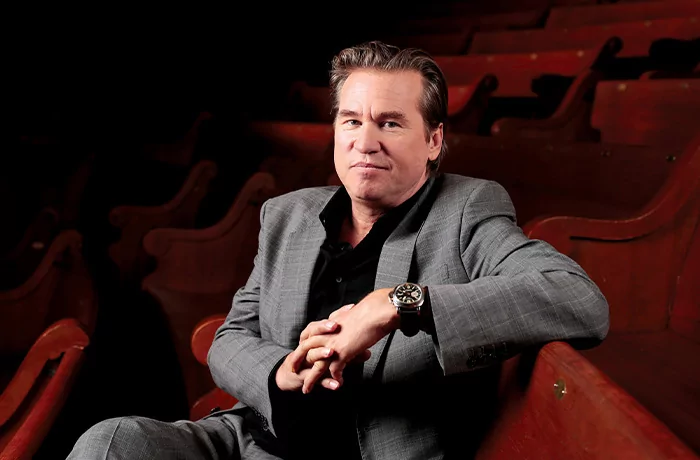Val Kilmer was a movie star who perceived something lacking in the business of being a movie star.
Although he had the countenance of a leading man and was born with a name that, though authentic, sounds almost made-up in the manner of, say, Rock Hudson, Kilmer consistently resisted and rejected the machinations of modern show business. He gravitated toward roles that made demands on his abilities or reflected his enthusiasm, and when he confronted a part that seemed pedestrian, he insisted on investing it with gravitas. In the process, Kilmer came to be spoken of as something of an irritant to directors and even other actors, but time has been kind to his insistence on standards.
The Kilmer filmography is chock-full of memorable parts in important movies, including Jim Morrison in The Doors (1991), Doc Holliday in Tombstone (1993), and as the aide-de-camp to Robert De Niro’s thief in Heat (1995). And his seriousness of purpose renders his appearances in popcorn entertainment, such as Top Gun (1986), Batman Forever (1995), and The Island of Dr. Moreau (1996), far more memorable than they deserve to be.

This career of cinematic accomplishment was interrupted when, in the mid-2010s, Kilmer was diagnosed with throat cancer, and it was brought to an end earlier this month when he died at age 65. Although his speaking voice had been permanently diminished due to the cancer and subsequent treatments, Kilmer retained his capacity for making art under unlikely conditions: In recent years, he enjoyed renewed attention for his original artwork. An admiring documentary about his life and times, 2021’s Val, made extensive and creative use of home video footage he himself shot.
Born in Los Angeles and educated at the Juilliard School in New York, Kilmer juggled the sacred and the profane from his earliest days in show business. He made an impression in the 1983 Broadway production of John Byrne’s play The Slab Boys, but he was not above parodying his persona in his debut film, the Zucker-Abrahams-Zucker 1985 spy spoof Top Secret! — and this was before he had even established a persona to parody. His sophomore film, 1986’s Real Genius, was in the same mold. Even in his 20s, then, Kilmer was something different: He was willing to accept silly parts, but only if he would be given free rein to perform them to their fullest — or their silliest.
With the success of Top Secret!, Real Genius, and, above all, Top Gun, in which he was arguably more persuasive and certainly more steely than co-star Tom Cruise, Kilmer purchased access to the more substantial parts he likely had been hankering for all along: He was volcanic in The Doors, roguishly appealing in Tombstone, and never less than memorable in everything ranging from the film noir Kill Me Again (1989) to the Quentin Tarantino-scripted True Romance (1994) to the adventure flick The Ghost and the Darkness (1996).
Although his status as a star was dinged on The Island of Dr. Moreau, whose director, the great John Frankenheimer, went public with his frustrations with the actor, Kilmer continued to try to bend studio productions to his actorly instincts. No Bruce Wayne was more effortlessly suave than his in Batman Forever, and he was permitted to make the most of the various guises adopted by the shapeshifting hero of 1997’s would-be blockbuster, The Saint. Kilmer’s smoothly distinctive voice, so tragically impaired following his cancer diagnosis, was on display as Moses in DreamWorks’s animated production The Price of Egypt (1998).
At the turn of the millennium, Kilmer committed himself to parts sometimes small, sometimes showy: as Willem de Kooning in Pollock (2000), as part of the background action in the Western The Missing (2003), and, memorably, in the main parts in David Mamet’s impressive Spartan (2004) and Francis Ford Coppola’s charmingly homemade horror flick Twixt (2011). No Oscar nominations were forthcoming — perhaps no other major actor of his generation was given fewer awards — but if one had any doubts that Kilmer beat to his own drum, consider the time and energy he invested into reincarnating himself as Mark Twain, whom he played in a one-man stage show and whose life he wanted to bring to the screen in the form of a dual biopic of Twain and Mary Baker Eddy, whose Christian Science faith Kilmer was an adherent of. It is virtually impossible to imagine any comparably famous movie star devoting himself to such a private and personal project with so little promise of financial returns.
Those plans were suspended with the onset of Kilmer’s illness, but he made ample use of the time he had left. He participated in the documentary about his life, wrote a memoir, 2020’s I’m Your Huckleberry, and soaked in the sort of adulation he was denied during the peak of his fame. Val Kilmer was right all along: Movies are better when the people who make them care about making them well.
Peter Tonguette is a contributing writer to the Washington Examiner magazine.























